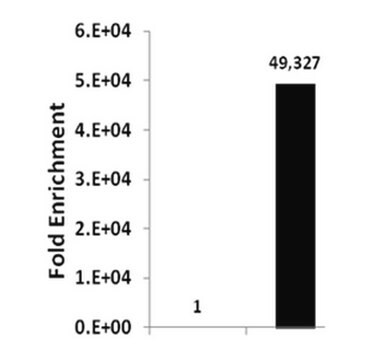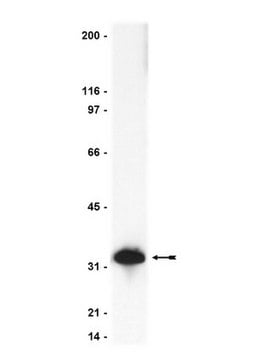17-10136
ChIPAb+ Dimethyl-Histone H3 (Lys36) - ChIP Validated Antibody and Primer Set
serum, from rabbit
Sinonimo/i:
H3K36me2, Histone H3 (dimethyl K36), H3 histone family, member T, Histone 3, H3, Histone cluster 3, H3
Scegli un formato
Scegli un formato
About This Item
Prodotti consigliati
Origine biologica
rabbit
Livello qualitativo
Forma dell’anticorpo
serum
Clone
polyclonal
Reattività contro le specie
vertebrates, human
Produttore/marchio commerciale
ChIPAb+
Upstate®
tecniche
ChIP: suitable
electrophoretic mobility shift assay: suitable
immunoprecipitation (IP): suitable
western blot: suitable
N° accesso NCBI
N° accesso UniProt
Condizioni di spedizione
dry ice
Descrizione generale
The ChIPAb+ Dimethyl Histone H3 (Lys36) set includes a Dimethyl Histone H3 (Lys36) antibody, a Normal Rabbit Serum, and positive control primers which amplify a 87 bp region of the human GAPDH coding region. The Dimethyl Histone H3 (Lys36) antibody and negative controls are supplied in a scalable "per ChIP" reaction size and can be used to functionally validate the precipitation of dimethyl Histone H3 (Lys36) associated chromatin.
Specificità
Immunogeno
Applicazioni
Sonicated chromatin prepared from HeLa cells (1e5 cell equivalents per IP) were subjected to chromatin immunoprecipitation using 1 µL of either Normal Rabbit Serum (Part No. CS200585), or 1 µL Anti-Dimethyl Histone H3 (Lys36) (Part No.CS207357) and the Magna ChIP HiSens (Cat. # 17-10460). Successful immunoprecipitation of dimethyl Histone H3 (Lys36) associated DNA fragments was verified by qPCR using ChIP Primers, GAPDH coding D2 (Part No. CS207323) as a positive locus, and GAPDH promoter (Part No. 22-004) as a negative locus. (Figure 2). Data are presented as percent input of each IP sample relative to input chromatin for each amplicon and ChIP sample as indicated.
Please refer to the Magna ChIP HiSens (Cat. # 17-10460) or EZ-MagnaChIP HiSens(Cat. # 17-10461) protocol for experimental details.
Chromatin Immunoprecipitation:
Sonicated chromatin prepared from HeLa cells (1e5 cell equivalents per IP) were subjected to chromatin immunoprecipitation using 1 µL of either Normal Rabbit Serum (Part No. CS200585), or 1 µL Anti-Dimethyl Histone H3 (Lys36) (Part No.CS207357) and the Magna ChIP HiSens (Cat. # 17-10460). Successful immunoprecipitation of dimethyl Histone H3 (Lys36) associated DNA fragments was verified by qPCR using ChIP Primers, GAPDH coding D2 (Part No. CS207323) as a positive locus, and GAPDH promoter (Part No. 22-004) as a negative locus. Please refer to the Magna ChIP HiSens (Cat. # 17-10460) or EZ-MagnaChIP HiSens(Cat. # 17-10461) protocol for experimental details.
Western Blotting Analysis:
A 1:10,000 dilution of this antibody detected dimethyl Histone H3 (Lys36) in 10 µg HeLa acid extract and demonstrated a loss of signal in 0.5 µg of unmethylated recombinant Histone H3
Dot Blot Analysis: Representative lot data.
Absurance Histone H3 Antibody Specificity Array (Cat. No. 16-667, Fig. A) Absurance Histone H2A, H2B, and H4 Antibody Specificity Array (Cat. No. 16-665, Fig. B) were probed with Anti-Dimethyl Histone H3 (Lys36) (1:10,000 dilution). Proteins were visualized using a Donkey Anti-Rabbit IgG secondary antibody conjugated to HRP and a chemiluminescence detection system.
Epigenetics & Nuclear Function
Histones
Confezionamento
Qualità
Please refer to the Magna ChIP HiSens (Cat. # 17-10460) or EZ-Magna ChIP HiSens (Cat. # 17-10461) protocol for experimental details.
Descrizione del bersaglio
Stato fisico
Normal Rabbit Serum, Part No. CS200585. One vial containing 25 µL antiserum containing 0.05% sodium azide. Store at -20°C.
ChIP Primers, GAPDH coding D2. Part No. CS207323. One vial containing 75 μL of 5 μM of each primer specific for human GAPDH coding region. (chr12:6647453+6647539, hg 19 build) Store at -20°C.
FOR: 5’ GCC ATG TAG ACC CCT TGA AGA GC 3’
REV: 5’ ACT GGT TGA GCA CAG GGT ACT TTA T 3’
Stoccaggio e stabilità
Risultati analitici
Includes normal rabbit serum and primers specific for human GAPDH, coding region.
Note legali
Esclusione di responsabilità
Codice della classe di stoccaggio
10 - Combustible liquids
Certificati d'analisi (COA)
Cerca il Certificati d'analisi (COA) digitando il numero di lotto/batch corrispondente. I numeri di lotto o di batch sono stampati sull'etichetta dei prodotti dopo la parola ‘Lotto’ o ‘Batch’.
Possiedi già questo prodotto?
I documenti relativi ai prodotti acquistati recentemente sono disponibili nell’Archivio dei documenti.
Filtri attivi
Il team dei nostri ricercatori vanta grande esperienza in tutte le aree della ricerca quali Life Science, scienza dei materiali, sintesi chimica, cromatografia, discipline analitiche, ecc..
Contatta l'Assistenza Tecnica.








